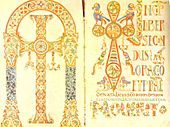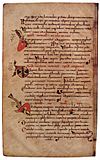Sacramentary
The Sacramentary , also known as the Sacramentarium , is a collection of prayers for the presiding officer of the Eucharist and other celebrations of worship. Further liturgical books such as the Lectionary or Gospel and the Gradual or Antiphonary are required for their implementation .
The sacramentary originated in late antiquity and the early Middle Ages. From 10./11. In the 19th century (see Missal of Benevento ) it was gradually replaced by the full missal , which contains all the texts of the mass. These were then largely standardized in the Missale Romanum of 1570.
Sacramentaries are important for medieval art history and iconography because, as holy books, they are often decorated with rich book illumination ( illuminations ) and equipped with precious book covers in goldsmith work , in which ivory plates were often inserted.
History of origin
The prayers and actions were transmitted orally for a long time. Over time, Euchologies emerged in the east , Roman and non-Roman sacraments in the west, such as the Gelasianum Vetus (GeV) (middle of the 7th century), which was divided into three books (Temporale, Sanctorale, Orations and Canon Missae ) Century (Junggelasianum), or the Gregorianum in its three branches from the 7th century, but only handed down through manuscripts of the 9th century (Type I Gregorianum-Hadrianum [GrH], supplemented by the Supplementum Anianense Benedikts by Aniane [Cambrai, Bibl. Municipale, 164], Type II Paduense [Padua, Bibl. Cap., D 47], Type III Prae-Hadrianum, [Trient, Castel del Buon Consiglio, sn] approx. 825 created for Arn von Salzburg ) and the Milanese , the Gallican, Celtic, Old Campanian, Old Spanish sacramentary.
The origins are hypothetical and the history up to the Carolingian Renovatio is very uncertain . The extent to which one can speak of a Traditio Apostolica and whether it had a written basis from the start is a pure matter of faith. In order to record the correct and correct prayers, libelli , small books, were created since late antiquity in which one wrote down what one needed for the liturgy on site. A mass liturgy was recorded for the first time in the libelli missarum . They were the first missal in Christianity, but did not contain a description of the rites. Soon there were a multitude of such libelli; these were taken together in larger books, the liturgical books. A distinction must be made between types of sacramentals and individual sacramentary manuscripts.
In the 7th century a first collection of prayers fixed in writing was created, the Sacramentarium Veronense (VE) (Verona, Bibl. Cap., Ms. LXXXV, first quarter of the 7th century), a first large collection of prayer texts still without ritual instructions. In the 8th century, in the course of the Pippin liturgical reform, Roman sacraments of the Gelasian type were mixed with Gallic material, resulting in the so-called Jungelasiana (also called "Gelasianum of the 8th century"). On the initiative of Charlemagne , the Carolingian renovatio was oriented more closely to the Roman model and the towering figure of Pope Gregory I , who, wrongly, was an urban Roman sacramentary that actually went back to Pope Honorius I (625-638) ("Gregorianum"), of which Pope Hadrian I had sent a copy ("Hadrianum") to Karl at his request. In the period that followed, new mixed types emerged that transferred Gelasian material into the Gregorian sacramentary.
Important sacramentaries
6./7. century
- Sacramentarium Leonianum ( Sacramentarium Veronense , Sacramentary Leo the Great ), Verona
- Sacramentarium Gelasianum ( Old Gelasianum , Sacramentary Gelasius' I. )
7th century
- Sacramentarium Gregorianum (Sacramentary Gregory the Great ), 715–731
- Sacramentary of Marinianus of Ravenna
- Sacramentarium Gallicanum (Gallic sacramentary)
8th century
- Sacramentarium Gregorianum-Hadrianum , according to legend, sent by Hadrian I to Charlemagne after he wanted to unify the liturgy of the Frankish Empire
- Sacramentary by Bobbio , 8th century
- Sacramentary Pippins ( Mixed Gelasianum , Young Gelasianum )
- Sacramentary of Gellone , around 780
- Sacramentary of the Arbeo of Freising
- Sacramentary of Rheinau , around 795/800
- Sacramentary of Angoulême
- Sacramentary of Monza
9th century
- Sacramentary of Amiens
- Sacramentary of Mainz , St. Alban's Abbey in front of Mainz
- Sacramentary of Trient ( Codex Tridentinus ), Säben Monastery around 825
- Sacramentary of Autun ( Codex Augustodunensis ), around 845
- Drogo Sacramentary , 850
- Sacramentary of Metz , 2nd half of the 9th century, probably made for Charles the Bald , with a famous depiction of the coronation
- Sacramentary of Echternach , end of the 9th century
- Pamelius-Sacramentary, Cologne 870-875 and 891-896
10th century
- Sacramentary of Fulda , Fulda Abbey around 975
- Sacramentary von Hornbach , Hornbach Monastery , around 983
- Sacramentary of Petershausen , Reichenau Monastery , around 970/980
- Sacramentary of St. Gereon , Cologne , between 996 and 1002
- Sacramentary of St. Paul in Lavanttal , Reichenau Monastery , around 970, with famous representations of liturgical acts
11th century
- Sacramentary of Bishop Warmondo / Warmund , 1000
- Sacramentary of Figeac , southern France
- Sacramentary of Venice
- Sacramentary of Salzburg
- Sacramentary of the Saint-Wandrille Abbey
- Sacramentary of Regensburg , of Henry II. Donated
- Sacramentary of Minden , donated by Bishop Sigebert
- Sacramentary of St. Gallen , around 1050, with a famous Pentecostal image
- Sacramentary von Lorsch , mid-11th century
- Sacramentary von Tyniec , Cologne, 1060-1070
12th Century
- Sacramentary of Tours
- Ratmann Sacramentary , 1159
- Sacramentary of Millstatt , 1170/1180
13th Century
- Sacramentary of Abbot Berthold , Weingarten Abbey , around 1215
- Hainricus-Sacrista-Sacramentary, around 1220
literature
- Jean Deshusses, Benoit Darragon: Concordances et tableaux pour l'étude des grands sacramentaires , Vol. 1–6 (Spicilegii Friburgensis subsidia.) Éditions Universitaires, Friborg / Suisse 1982–1983
- Klaus Gamber : Types of Sacraments. Attempt to group the manuscripts and fragments up to the turn of the millennium , Vol. 1–3, 4 (Texts and Works 1, 49/50). Beuroner Kunstverl., Beuron 1958
- Éric Palazzo: Le Moyen Âge des origines au XIIIe siècle. Histoire des livres liturgiques . Beauchesne, Paris 1993. ISBN 2-7010-1280-5 ; (translated by Madleine Beaumont): A history of Liturgical books. From the beginning to the thirteenth century . The Liturgical Press, Collegeville (Minnesota) 1998. ISBN 0-8146-6167-X
- Cyrille Vogel: Introduction aux sources de l'histoire du culte chrétien au moyen Age Centro Italiano di Studi sull'alto Medioevo, Spoleto 1981; (revised and updated edition translated by William G. Storey): Medieval Liturgy. An introduction to the sources . Pastoral Press, Washington DC 1986. ISBN 0-912405-10-4
Web links
- Literature on sacramentaries in the Opac of the Regesta Imperii
- Fulda Sacramentary - BSB Clm 10077







